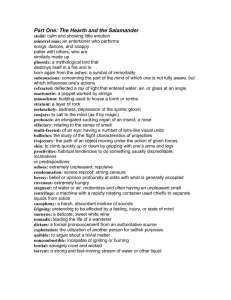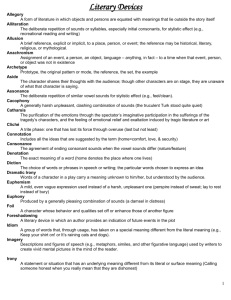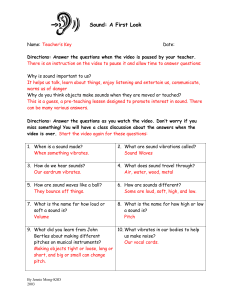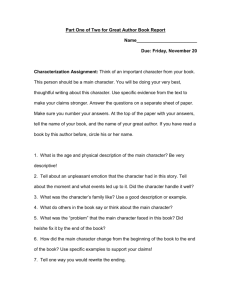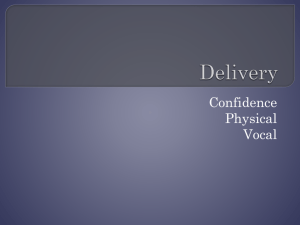POLLUTION SECTION 11-WHAT’S IN A SOUND? OBJECTIVES
advertisement
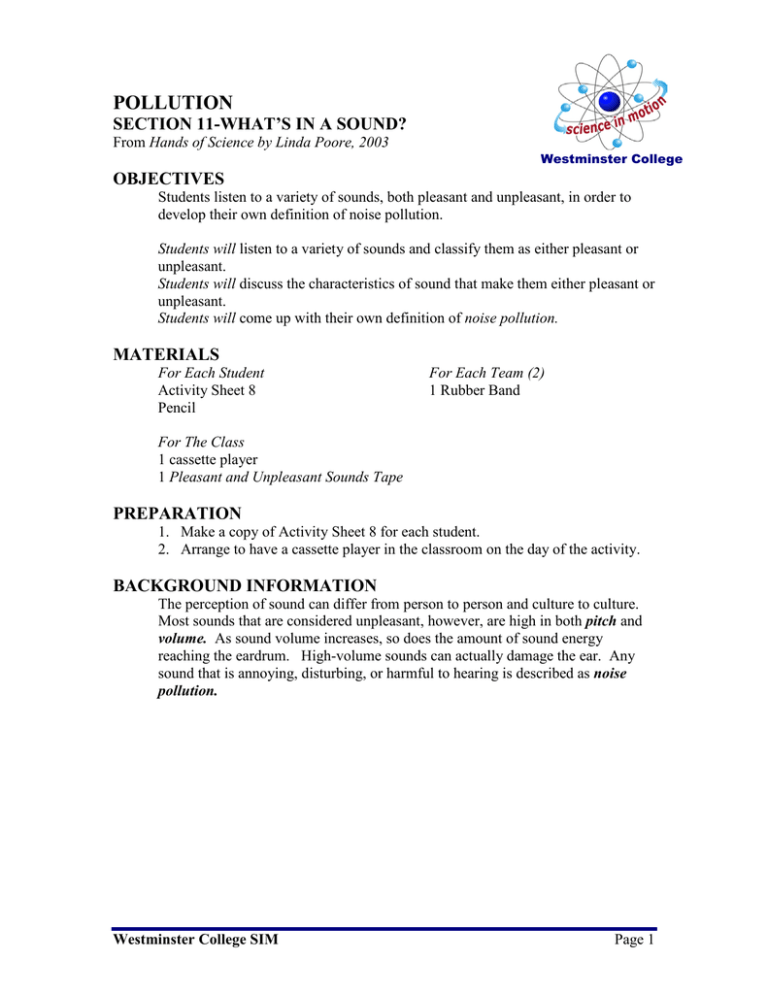
POLLUTION SECTION 11-WHAT’S IN A SOUND? From Hands of Science by Linda Poore, 2003 Westminster College OBJECTIVES Students listen to a variety of sounds, both pleasant and unpleasant, in order to develop their own definition of noise pollution. Students will listen to a variety of sounds and classify them as either pleasant or unpleasant. Students will discuss the characteristics of sound that make them either pleasant or unpleasant. Students will come up with their own definition of noise pollution. MATERIALS For Each Student Activity Sheet 8 Pencil For Each Team (2) 1 Rubber Band For The Class 1 cassette player 1 Pleasant and Unpleasant Sounds Tape PREPARATION 1. Make a copy of Activity Sheet 8 for each student. 2. Arrange to have a cassette player in the classroom on the day of the activity. BACKGROUND INFORMATION The perception of sound can differ from person to person and culture to culture. Most sounds that are considered unpleasant, however, are high in both pitch and volume. As sound volume increases, so does the amount of sound energy reaching the eardrum. High-volume sounds can actually damage the ear. Any sound that is annoying, disturbing, or harmful to hearing is described as noise pollution. Westminster College SIM Page 1 WHAT’S IN A SOUND Westminster College SIM Page 2 WHAT’S IN A SOUND GUIDING THE ACTIVITY 1. Have the students lightly tap a pencil on their desks, and ask them to describe the sound. Most students should describe the sound as quiet or rhythmic. Have them gradually increase the strength of their tapping? Ask, What is happening to the sound? Students should notice that it is getting louder. 2. Write the word volume on the board, and explain to the students that they have just increased the volume (the degree of loudness, or intensity) of the sound their pencils make hitting the desks. Elicit that volume is the loudness or softness of a sound. 3. Divide the class into teams of two and distribute a rubber band to each team. Safety note: Caution students to handle the rubber band carefully to ensure that none are “accidentally” shot across the room. Also remind them to keep the rubber bands away from their faces. Have one member stretch the rubber band stretch the rubber band loosely while the other plucks it as if it were the string of a musical instrument. Have them listen carefully to the sound it makes. Then have them stretch the rubber band a bit tighter and pluck it again. Ask, How does the sound change? Students should note that the sound gets higher as the rubber band is stretched tighter. 4. Write the word pitch on the board, and explain that the pitch of a sound refers to how high or low the sound is. Tell students that the loose rubber band vibrates slowly, producing a low pitch. Tightening the rubber band caused it to vibrate more quickly, producing a higher pitch. 5. Distribute Activity Sheet 8 and tell the students that they are going to listen to some sounds. As they listen, they are to complete the chart on the activity sheet, first by writing down the source of any sounds they recognize, then by deciding if each sound has a high or low intensity and a high or low pitch. Finally, they are to decide for themselves if the sound is pleasant or unpleasant. Remind them that a sound that one person finds pleasant may be unpleasant to someone else. Westminster College SIM Page 3 WHAT’S IN A SOUND 6. While students are listening to the tape, draw a simplified version of the chart on Activity Sheet 8 on the board. Include only first, fifth and sixth columns. When the students have finished listening to the tape and have completed the chart on the activity sheet, ask for a show of hands to the following questions: How many of you found sound number 1 to be pleasant? How many found sound number 2 to unpleasant? Responses may vary from one student to the next. Record the totals on the board. Repeat this exercise for all twenty sounds. Have students examine the chart and identify those sounds which most or all of the class agreed were pleasant, and those which most or all of the class agreed were unpleasant. Ask, What were the characteristics of the sounds that you classified as pleasant? as unpleasant? Most students will say that the pleasant sounds were soft or did not interrupt their conversations or train of thought, and that unpleasant sounds were loud, startling, or made them feel uncomfortable in some way. Have volunteers come to the board and write an L next to those sounds that were low in pitch and intensity. Ask, Do you see a relationship between the pitch and intensity of a sound and the pleasantness or unpleasantness of that sound? Students should see that sounds that were low in pitch and intensity were most often classified as pleasant. Sounds that were high in pitch and intensity were most often classified as unpleasant. Ask, What other characteristics of sounds make them pleasant or unpleasant? Students will probably suggest the words rhythmic and soothing to describe a pleasant sound, and shrill or grating to describe a sound that is unpleasant. Others may mention that unpleasant sounds “hurt” their ears. 7. Divide the class into small discussion groups and have them develop a definition of pleasant and unpleasant sounds. Invite the groups to share these definitions with the class. Some teams may simply define a peasant sound as one they enjoy listening to and an unpleasant sound as one that makes them feel uncomfortable. Write noise pollution on the board and ask groups to draw on their definitions of pleasant and unpleasant sounds to help you define the term. Help students understand that noise pollution can be any sound in the environment that is annoying, distracting, or that damages hearing. Westminster College SIM Page 4
